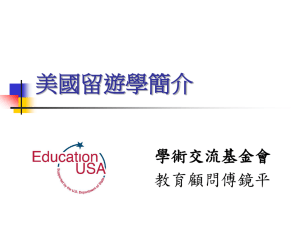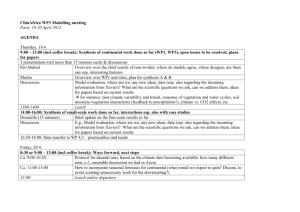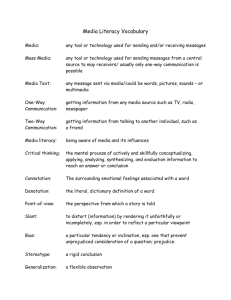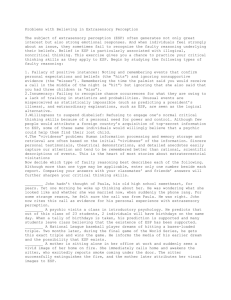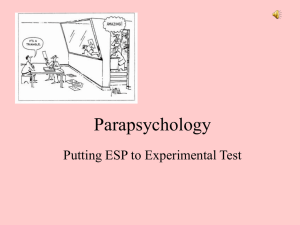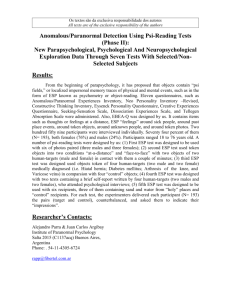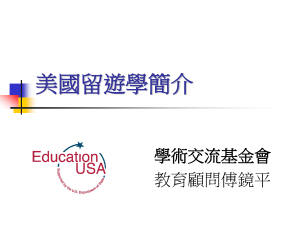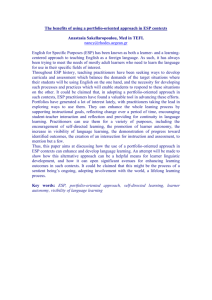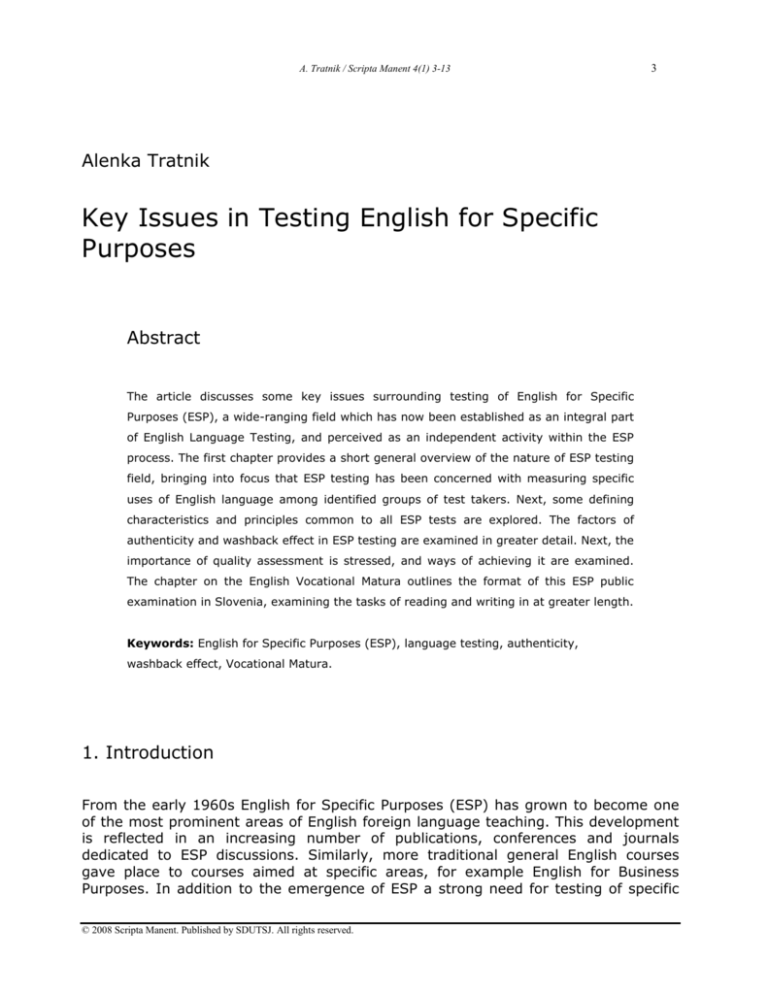
A. Tratnik / Scripta Manent 4(1) 3-13
3
Alenka Tratnik
Key Issues in Testing English for Specific
Purposes
Abstract
The article discusses some key issues surrounding testing of English for Specific
Purposes (ESP), a wide-ranging field which has now been established as an integral part
of English Language Testing, and perceived as an independent activity within the ESP
process. The first chapter provides a short general overview of the nature of ESP testing
field, bringing into focus that ESP testing has been concerned with measuring specific
uses of English language among identified groups of test takers. Next, some defining
characteristics and principles common to all ESP tests are explored. The factors of
authenticity and washback effect in ESP testing are examined in greater detail. Next, the
importance of quality assessment is stressed, and ways of achieving it are examined.
The chapter on the English Vocational Matura outlines the format of this ESP public
examination in Slovenia, examining the tasks of reading and writing in at greater length.
Keywords: English for Specific Purposes (ESP), language testing, authenticity,
washback effect, Vocational Matura.
1. Introduction
From the early 1960s English for Specific Purposes (ESP) has grown to become one
of the most prominent areas of English foreign language teaching. This development
is reflected in an increasing number of publications, conferences and journals
dedicated to ESP discussions. Similarly, more traditional general English courses
gave place to courses aimed at specific areas, for example English for Business
Purposes. In addition to the emergence of ESP a strong need for testing of specific
© 2008 Scripta Manent. Published by SDUTSJ. All rights reserved.
A. Tratnik / Scripta Manent 4(1) 3-13
4
groups of learners was created. As a result, ESP testing movement has shown a slow
but definite growth over the past few years. In this article it is my intention to
discuss some key issues surrounding the field of ESP testing. I will begin the
discussion by addressing the nature and characteristics of ESP testing, underline the
principles of good testing practice, and offer examples of reading and writing tasks
used in the English Vocational Matura in Slovenia.
2. Testing of English for Specific Purposes
This section presents three views of ESP testing. Firstly, the field of ESP testing has
been seen as a separate and distinctive part of a more general movement of English
language testing, focusing on measuring specific uses of English language among
identified groups of people, such as doctors, nurses, lawyers, civil engineers, tour
guides, air traffic controllers, and others.
Secondly, ESP testing has been viewed in the broader context of the teaching and
learning process. From the perspective of Dudley-Evans and St. John (1998)
assessment does not stand alone, but occupies a prominent place in the ESP process,
giving an ESP teacher a wealth of information on the effectiveness and quality of
learning and teaching. As shown in Figure 1 assessment interacts with needs
analysis, and is dependent on course (and syllabus) design.
Figure 1: Stages in the ESP process (Dudley-Evans and St. John 1998: 121)
Thirdly, tests enhance the learning process and act as a learning device. Put in the
words of Dudley-Evans and St. John (1998: 212) an ESP test is »an aid to learning«.
Moreover, assessment evaluates the benefits of learning, tests can give learners a
sense of accomplishment and a feeling that the teacher’s evaluation matches what
skills and knowledge have been covered. Along the same lines, Richards and
Renandya (2002) suggest that assessment yields an observed judgement of the
effectiveness of teaching. Dudley-Evans and St. John (1998: 210) add that
assessment »encompasses benefits such as reinforcement, confidence building,
involvement and building on strengths«.
© 2008 Scripta Manent. Published by SDUTSJ. All rights reserved.
A. Tratnik / Scripta Manent 4(1) 3-13
5
3. Characteristics of ESP tests
Specific purpose testing is primarily concerned with facilitating learners to perform
particular communicative tasks, providing feedback on learning, confirming what
students have mastered and highlighting those skills needing further attention,
encouraging learning, and monitoring progress.
In principle, any ESP test can be classified as a performance test assessing the skills
needed to »perform« in the language successfully. Given that language performance
in individuals varies according to the context in which the language is used, then the
test taker’s performance on a test depends largely on the interaction between
language knowledge and specific purpose content knowledge. Unlike general English
tests, which can be used with young learners (e.g. Cambridge Young Learners Test)
or adults (e.g. First Certificate in English), ESP tests are more likely to be used with
adults or secondary school learners at intermediate and advanced level, or learners
who have already acquired basic knowledge of the language system.
Douglas (2000: 10) cites that ESP tests are »contrived language use events« in
which, ideally, the test taker’s specific purpose language ability and knowledge of the
specialist field are measured. If we keep in mind that language ability refers to what
a learner can do in or with a language, then what really matters in ESP testing is
whether learners can communicate in a specific target language and use knowledge
of the field in order to achieve their aims, in order to understand and be understood,
in order to get their message across in English.
ESP tests are related in content, themes and topics to particular disciplines, and
involve a higher degree of language specificity. Special lexical, semantic and
syntactic characteristics of technical language, in addition to its communicative
function enable people in a particular academic, professional or vocational field to
convey the meaning more specifically. Precision in language is therefore a unique
concept in specific purpose language testing.
Not only that, ESP testing enterprise is designed upon the demands of the linguistic
characteristics of the specialist area of work or study, as language varies from one
situation to another. There are important differences between, say, an English test of
engineers and that of tourist guides, as they address the nature of particular
varieties of English from a specific vocational and professional field.
Further, one of the prevailing principles of ESP testing is that tests should contain
tasks that mirror faithfully those of the candidates' target language use situation.
This leads us to a view of ESP testing in which tests are developed on the basis of a
detailed analysis of characteristics of context and tasks in target language use
situation. The target language profile for assessing a specific group of learners would
thus entail samples of communication activities, communication purposes, linguistic
features, functions, descriptions of content areas, language skills, etc. For instance, if
we were to devise an English test for tourist guides, we would first describe a range
© 2008 Scripta Manent. Published by SDUTSJ. All rights reserved.
A. Tratnik / Scripta Manent 4(1) 3-13
6
of typical situations in which tourist guides work, typical uses and characteristics of
English language that they most often find themselves in.
In that case, if an awareness of the learners' needs shapes the design of an ESP
course and teaching materials, then the analysis of the learner's target language use
situations is the first and perhaps the most important stage in designing an ESP test.
A thorough coverage of typical real-life communicative events would, firstly, result in
the selection and creation of suitable test tasks, secondly, facilitate a more
integrated and thematically linked assessment, in which test tasks authentically
characterize the reality of the learners, and, not lastly, such tests would have higher
validity (Douglas 2000; Hutchinson and Waters 1987; Munby 1978).
Accordingly, ESP tests are more concerned to present learners with tasks that
involve them in reading, listening to, speaking or writing the target language, and
evaluating how well they can do this. Of course, an important component in
assessing how well somebody can use English is how accurately they can produce or
understand texts written or spoken in the language, but the key to this assessment
is to present learners with tasks that resemble in some way the sort of things they
may have to do with the language in real life. Therefore, the ESP approach in testing
is based on the analysis of learners’ target language use situations and specialist
knowledge of using English for real communication.
In view of what has been said it is clear that an ESP test is one in which the purpose,
the test content and the methods are more narrowly defined. Consider for instance
tests in English for Civil Engineers or Military Service devised for the purpose of
evaluating occupational language abilities. If we accept the existence of specific
purpose tests as described here, the next question might be: How many ESP tests
are there? Namely, specific purposes can be wide or narrow, vocational or academic,
including anything from English for Airport Controllers, Chemists or Hoteliers to Legal
English and beyond. This diversity in itself poses a question: Is ESP testing truly
possible between such widely differing fields or does each field of human activity
have an ESP test of its own?
To my mind, no human activity and no specific purpose field can simply be classified
without overlaps. Thus, the line where one ESP test begins and where another ESP
test ends is very vague indeed. A test that is constructed for chemistry engineering
and a test devised for assessing lawyers, although belonging to various fields, tend
to share a number of features. What is truly fascinating about the practice and
testing of ESP is that the vast repertoire of specific tests offered is also underpinned
by a common structure of testing principles and techniques. In this sense, then, ESP
testing provides a framework relevant across different disciplines.
© 2008 Scripta Manent. Published by SDUTSJ. All rights reserved.
A. Tratnik / Scripta Manent 4(1) 3-13
7
4. Assuring the quality of ESP tests
When devising an ESP test one should aim at creating good and dependable
measures of language ability which need to:
- be as authentic as possible,
- provide accurate and reliable measures of language ability,
- have beneficial effects,
- be practical and economical in terms of administration, time, money and
personnel.
Most authors (Alderson et al. 1995; Bachman and Palmer 1996; Douglas 2000;
Dudley-Evans and St. John 1998) identify authenticity of task, reliability, validity,
practicality and economy as the most important factors affecting the quality of a test
in a positive or negative way. A detailed account of the above-mentioned factors
would go beyond this paper, therefore, I shall briefly define the element of
authenticity as one of the salient features of ESP tests.
In case of authenticity, test takers should be engaged in a variety of genuine tasks in
which language ability and field specific content knowledge interact in a way which is
similar to the student’s real-life language use. This interaction between language
knowledge and specific purpose content knowledge makes an integral part of the
whole ESP testing concept. When authentic language and material are discussed, we
usually think of language used in non-test or non-pedagogic texts, language referring
to real-life situations and natural communication, and texts close to the readers’
needs and language use.
Accordingly, in the ESP testing situation authenticity of task refers the similarity of
the test task to the target language use situation, the more authentic a text or task
is, the more probable it is for the test taker to carry out the test task in the same
way, as he/she would perform it in the actual target situation. Thus, authentic texts
and tasks are representative of the specific language use situation or similar to the
tasks a test taker actually performs in his/her work.
Another important factor in ESP testing is backwash or washback effect. The notion
of backwash is that of impact, which seeks to investigate the relationship between
test use and the ESP situation in which it is used (Hughes 1989). Put simply, it is the
effect of testing on classroom instruction, on »what is taught and how it is taught«
(Dudley-Evans and St. John 1998: 214). Tests, especially those that are important
for the test takers, may generate positive or negative backwash.
The research that has been conducted in this area (Karim 2002) indicates that the
relationship between testing and teaching is very complex and it is misleading to
claim that good tests will automatically have beneficial effects on classroom
instruction. Other variables such as teacher competence, motivation and innovation,
the climate of the school, socioeconomic status of pupils and teachers combine to
exert an equally important influence on what goes on in an ESP classroom.
© 2008 Scripta Manent. Published by SDUTSJ. All rights reserved.
A. Tratnik / Scripta Manent 4(1) 3-13
8
However, if a test is regarded as important, then preparation for it can dictate
teaching and learning activities. More importantly, a public examination might be a
signal to students (and teachers) about what is important and what is not. Consider
for instance the English Vocational Matura in Slovenia, which has been administered
for six years now, and does not include a listening section – a skill that encompasses
a quarter of the English language syllabus. If test developers responsible for
constructing the English Vocational Matura keep ignoring listening year after year,
they are somehow telling teachers (and students) that this skill is less important and
that they can spend less time on it.
We have looked at some cases of harmful backwash. However, backwash need not
always be harmful, it can be positive too. An ESP test, which would be based directly
on an analysis of English language needs of a specific group of learners as similar as
possible to those which they would have to perform in real life, would probably be a
more plausible case of beneficial backwash than a case in which no such analysis
would be carried out.
In short, what matters in ESP testing is whether learners can communicate in the
field specific target language and use knowledge of the field in order to achieve their
aims, in order to understand and be understood, in order to get their message across
in English. The Common European Framework of References for Languages, devised
by the Council of Europe, and increasingly becoming the standard for language
curricula, textbooks, and other teaching materials, language examinations and
assessment procedures, has similar aims.
5. The English Vocational Matura in Slovenia
The Vocational Matura in Slovenia is a public examination, in which candidates
demonstrate the achievement of standards of knowledge determined by objectives of
educational programmes of secondary technical schools, vocational-technical schools
and other vocational education. It is a final task-based achievement exam. If
candidates pass it, they acquire a secondary vocational education, by which they
prove the ability to work in a certain technical area and obtain a qualification for
employment directly after completing their education.
An essential feature of ESP formal testing is related to the specific test content.
Green (2004) reminds us that background knowledge has an effect on test results.
The fact that the candidates sitting the English Vocational Matura come from wideranging backgrounds poses a question: How do we specify the domain of content if
we want to test language ability of students coming from different secondary
vocational schools? Alderson (cited in Dudley-Evans and St. John 1998: 216)
suggests that one-test solution seems to be the most convenient. Having looked at
live English Vocational Matura exams, I can assert that the national subject
© 2008 Scripta Manent. Published by SDUTSJ. All rights reserved.
9
A. Tratnik / Scripta Manent 4(1) 3-13
commission constructing the English Vocational Matura normally selects carrier
content that is as neutral and comprehensible as possible.
In its six-year long history, the format of the English Vocational Matura has not
changed considerably. The examination comprises four components: reading, use of
language, writing and speaking. I shall examine the tasks of reading and writing
more closely to see how they illustrate various features of ESP testing practice.
5.1. Assessing reading
In the reading section of the examination there are two independent reading tasks,
each based on a different reading passage of up to 650 words. 30 minutes are
provided to complete both reading tasks, however, no suggestion is given on how
long to spend on each task. We will look at a reading passage and a True/False test
method from the Vocational Matura live exam administered in June 2006. The
instructions for the second reading task run as follows:
Read the text Experts say fairy tales not so happy ever after and decide whether the
statements below are true (T) or false (F). Put a tick () in the appropriate box after
each statement. If you correct your answers, the corrections should be as clear as
possible, or else the answer will be invalid.
T
F
1. Ms Baker-Sperry used to go to Purdue University.
2. In our society women should depend on their intelligence.
3. The researchers analyzed forty-three fairy tales.
4. 'Little Red Riding Hood' is the only tale which has been reproduced
more than 100 times.
5. Fairy tales suggest women should be and stay beautiful.
6. One of the stories mentions male looks 114 times.
7. Fairy tales have a negative influence on young women.
(7 points)
Figure 2: Vocational Matura Reading task (2006)
The rubric gives the procedures for responding, along with a general reminder of the
need for clear corrigenda. Test takers are told how to correct their responses and are
given a reason why it is important to write their answers clearly. On the other hand,
the rubric does not contain information about the time allotment, there is no
statement about what abilities the task is meant to assess, or any evaluation criteria,
apart from the number of points each answer is worth.
© 2008 Scripta Manent. Published by SDUTSJ. All rights reserved.
A. Tratnik / Scripta Manent 4(1) 3-13
10
The input data for questions 1–7 is a fairly authentic text about fairy tales, as
reproduced below.
Experts say fairy tales not so happy ever after
By Amy Patterson-Neubert
11 November 2003
WEST LAFAYETTE, Ind. – Fairy tales about pretty princesses winning Prince Charming are more
harmful than parents might think, says a Purdue University sociologist. Liz Grauerholz, an associate
professor of sociology, teamed with Lori Baker-Sperry, an assistant professor of women's studies at
Western Illinois University and a former Purdue graduate student, to study how beauty is written about
in fairy tales and whether stories with beautiful princesses are more likely to be popular. Grauerholz
says parents need to be aware that some stories tell children that unattractive people are more likely
to be evil and reinforce traditional gender roles that may be confusing for today's young women.
"Fairy tales, which are still read by millions of American children, say it pays to be pretty," Grauerholz
says. "It's important to understand the messages our children receive about traditional gender roles,
especially during a time when women are encouraged to be independent and rely on their brains
rather than beauty. Grauerholz and Baker-Sperry examined 168 Brothers Grimm fairy tales. These
stories were written by Jacob and Wilhelm Grimm in the 1800s and were used in central Europe to
teach children the roles boys and girls should play, as well as what it means to be good or bad. Of the
tales analyzed, 43 percent have been reproduced in children's books or movies.
The five tales that have been reproduced more than 101 times are "Cinderella," "Snow White," "Briar
Rose" (also known as "Sleeping Beauty"), "Little Red Cap" (also known as "Little Red Riding Hood")
and "Hansel and Gretel." The researchers found that the majority of fairy tales that survived into the
20th century feature characters with young, beautiful princesses. This trend reinforces the message to
children that physical attractiveness is an important asset women should aim to achieve and maintain,
Baker-Sperry says.
Their analysis showed that 94 percent of the Grimms' fairy tales acknowledged physical appearance,
and the average references per story were 13.6. In one story, there were 114 beauty references for
women. In comparison, the number of beauty references for men did not exceed 35 per story.
"Hearing these messages that were created by an old, patriarchal society may cause women,
especially young girls, to withdraw from activities or careers, such as competitive sports or hard labor,
because it is not part of being feminine," Grauerholz says. "This continued emphasis on beauty is a
way society controls girls and women. Women adopt behaviors that reflect and reinforce their relative
powerlessness, which can lead to limiting a woman's personal freedom, power and control."
Article from http://news.uns.purdue.edu/UNS/html4ever/031111.Grauerholz.tales.html
Figure 3: Vocational Matura Reading Task (2006)
The sole focus of the reading section is to demonstrate comprehension. As
mentioned before there is no field specific purpose or even measurement purpose,
apart from the testing purposes, provided for reading this text. A statement of
purpose would enhance interactional authenticity of the input data and match an
already high level of situational authenticity. The input requires a moderate
engagement of background knowledge about Brothers Grimm. The relationship
between the input and the response is very direct, in that the information needed to
complete the task is included in the text, although as suggested above, a certain
amount of background knowledge is needed.
The task appears to be quite close to the general end of the specificity continuum.
The text itself though is not intrinsically interesting or challenging, the obvious
© 2008 Scripta Manent. Published by SDUTSJ. All rights reserved.
11
A. Tratnik / Scripta Manent 4(1) 3-13
weakness of this type of test method is that candidates have a 50% chance of
guessing the right answer, which clearly affects the validity of this test method. One
way of avoiding guessing is to add another distracter, in this case, »not included in
the text« category would reduce the likelihood of guessing to 33%. The second
option of reducing guessing is to modify the task by requiring test takers to give a
reason for their choice. However, this extra requirement can be problematic, as the
candidates have to write the solutions and writing as a skill is not intended to be
tested here.
5.2. Assessing writing
The writing section contains two tasks, one requiring the test takers to write a short
composition for a school newspaper and the other to write a formal or semi-formal
letter. Since the second of these tasks consists of a rather straightforward prompt for
a 40-minute letter, we will look at the first, somewhat more interesting task. A
typical writing task includes the following:
A short composition (Allotted time: 20 minutes)
(10)
Write a short composition (70 words) for a school newspaper in which you discuss problems in
urban communities. Choose to discuss only one of the problems indicated below, examine its
harmful effects, and offer at least one piece of advice on how to solve the problem.
alcohol
drugs
vandalism
Figure 4: Vocational Matura Writing Task (2006)
We see that time allotment and information about length are specified in the rubric.
There is specific information about what to include in the article. Besides, the rubric
(in Slovene) includes the content of the task (urban problems), the audience of the
writing task (readers of a school newspaper), and the genre (article). Test takers are
provided with about 20 lines to write the composition, there is no space for the draft
© 2008 Scripta Manent. Published by SDUTSJ. All rights reserved.
A. Tratnik / Scripta Manent 4(1) 3-13
12
of the article. There is no information about what the objective of the writing task
might be. Further, no information, apart from the total number of points, in this case
10, is given about the evaluation criteria. In the Vocational Matura catalogue we are
told that candidates are assessed in content, vocabulary and cohesion. This
information is addressed to teachers so that they might prepare candidates for the
examination, and to students taking English as their third elective subject. The same
document informs task takers that dictionaries may be used.
The visual input data does not add much to the authenticity of the task but simply
supports the rubric. The task is non-reciprocal, although candidates are given some
choice as to what problem to describe. The language required in the response does
not require a wide range of vocabulary and syntactic forms; cohesion and
organization are more important parts of the construct. In terms of background
knowledge necessary for completing this task, the test taker might need some prior
knowledge of health or medical problems (harmful effect of drugs, alcohol on
people). One must wonder, however, whether the topic might be too sensitive for a
teenage candidate.
Overall, writing an article for a school newspaper is a moderately authentic response
task, although, as suggested above, information about purpose and some
information on what aspects of writing will be evaluated would make the task
potentially more interactionally authentic.
6. Conclusion
Developing foreign language skills enhances personal and professional fulfilment, and
reflects the process of lifelong learning. Therefore, special attention in ESP teaching
should be focused on ways of promoting skills, which encourage and enable learners
to respond to different day-to-day situations and react properly in special
circumstances. Similarly, ESP tests should be based on direct evaluation of language
ability in acts of communication (reading, speaking, writing, and listening) and
assessment of content knowledge in situations and activities, which are as engaging
and realistic as possible for learners. Seen from this point, teachers should devise
such test tasks, which enable the learner to see the connection between language
uses required in tests (which are mostly simulations) and real-life language uses.
The primary goal of ESP tests is to obtain information about the learner's specific
purpose language ability. This information is often very useful and at times even
necessary. Modern Europe encourages mobility of labour and of students across the
European Union and beyond. In order to be able to take up study places or work
opportunities, knowledge of foreign language is essential. In present day, it is
increasingly important not only to be able to use a foreign language, but also to be
able to demonstrate that one can use it at the level required by employers, schools,
© 2008 Scripta Manent. Published by SDUTSJ. All rights reserved.
A. Tratnik / Scripta Manent 4(1) 3-13
13
or universities. Considering this, ESP examinations are gaining more and more
attention, and are becoming an indispensable tool in the modern educational society.
Bibliography
Alderson, J. C., Clapham, C., and Wall, D. (1995). Language Test Construction and Evaluation.
Cambridge: Cambridge University Press.
Bachman, L. F., and Palmer, A. S. (1996). Language testing in practice. Oxford: Oxford University
Press.
Čebron, N. (ed.) (1998). New Challenger in Teaching ESP in Slovenia – conference proceedings.
Ljubljana: Društvo za tuje jezike in književnosti.
Douglas, D. (2000). Assessing Languages for Specific Purposes. Cambridge: Cambridge University
Press.
Dudley-Evans, T., and St. John, M. J. (1998). Developments in English for Specific Purposes.
Cambridge: Cambridge University Press.
Green, R. (2004). Language testing. Seminar material. Bled, 2–4 March.
Hughes, A. (1989). Testing for Language Teachers. Cambridge: Cambridge University Press.
Hutchinson, T., and Waters, A. (1987). English for Specific Purposes: A learning-centred Approach.
Cambridge: Cambridge University Press.
Karim, M. A. (2002). High Stakes Examination: Washback in the Language Classroom. Paper presented
at the 28th conference of the International Association for Educational Assessment Reforming
Educational Assessment to Meet Changing Needs. Hong Kong, China.
Munby, J. (1987). Communicative Syllabus Design. Cambridge: Cambridge University Press.
Predmetni izpitni katalog za poklicno maturo – angleščina (2005). Ljubljana: Državni izpitni center.
© 2008 Scripta Manent. Published by SDUTSJ. All rights reserved.


